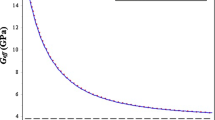Abstract
A shear-lag model is used to study the mechanical properties of bone-like hierarchical materials. The relationship between the overall effective modulus and the number of hierarchy level is obtained. The result is compared with that based on the tension-shear chain model and finite element simulation, respectively. It is shown that all three models can be used to describe the mechanical behavior of the hierarchical material when the number of hierarchy levels is small. By increasing the number of hierarchy level, the shear-lag result is consistent with the finite element result. However the tension-shear chain model leads to an opposite trend. The transition point position depends on the fraction of hard phase, aspect ratio and modulus ratio of hard phase to soft phase. Further discussion is performed on the flaw tolerance size and strength of hierarchical materials based on the shear-lag analysis.
Similar content being viewed by others
References
Curry, J.D., Mechanical properties of mother of pearl in tension//Proc. R. Soc. Lond. B., 1977, 196: 443–463.
Jackson, A.P., Vincent, J.F.V. and Turner, R.M., The mechanical design of nacre//Proc. R. Soc. Lond. B., 1988, 234: 415–440.
Norman, T.L., Vashishth, D. and Burr, D.B., Fracture toughness of human bone under tension. J. Biomech., 1995, 28: 309–320.
Jager, I. and Fratzl, P., Mineralized collagen Mbrils: a mechanical model with a staggered arrangement of mineral particles. Biophys. J., 2000, 79: 1737–1746.
Song, F., Soh, A.K. and Bai, Y.L., Structural and mechanical properties of the organic matrix layers of nacre. Biomaterials, 2003, 24: 3621–3631.
Wang, R.Z., Wen, H.B., Cui, F.Z., et al., Observation of damage morphologies in nacre during deformation and fracture. J. Mater. Sci., 1995, 30: 2299–2304.
Weiner, S. and Wagner, H.D., The material bone: structure-mechanical function relations. Annual Review of Materials Science, 1998, 28: 271–298.
Weiner, S., Veis, A., Beniash, E., Arad, T., Dillon, J.W., Sabsay, B. and Siddiqui, F., Peritubular dentin formation: crystal organization and the macromolecular phases in human teeth. J. Struct. Biol., 1999, 126: 27–41.
Menig, R., Meyers, M.H., Meyers, M.A. and Vecchio, K.S., Quasi-static and dynamic mechanical response of Haliotis rufescens (abalone) shells. Acta Materialia, 2000, 48: 2383–2398.
Currey, J.D., The Mechanical Adaptations of Bones. Princeton, NJ: Princeton University Press, 1984, 24–37.
Landis, W.J., The strength of a calcified tissue depends in part on the molecular structure and organization of its phase mineral crystals in their organic matrix. Bone, 1995, 16: 533–544.
Rho, J.Y., Kuhn-Spearing, L. and Zioupos, P., Mechanical properties and the hierarchical structure of bone. Medical Engineering & Physics, 1998, 20: 92–102.
Ager, J.W., Balooch, G. and Ritchie, R.O., Fracture, aging, and disease in bone. J. Mater. Res., 2006, 21(8): 1878–1892.
Gao, H. and Ji, B., Modeling fracture in nanomaterials via a virtual internal bond method. Engineering Fracture Mechanics, 2003, 70: 1777–1791.
Wang, R.Z., Suo, Z., Evans, A.G., Yao, N. and Aksay, I.A., Deformation mechanisms in nacre. J. Mater. Res., 2001, 16: 2485–2493.
Gao, H., Application of fracture mechanics concepts to hierarchical biomechanics of bone and bone-like materials. International Journal of Fracture, 2006, 138: 101–137.
Kotha, S.P., Kotha, S. and Guzelsu, N., A shear-lag model to account for interaction effects between inclusions in composites reinforced with rectangular platelets. Composites Science and Technology, 2000, 60: 2147–2158.
Author information
Authors and Affiliations
Additional information
Project supported by the National Natural Science Foundation of China (Nos. 10432050, 10428207 and 10672163), and the Chinese Academy of Sciences through Grant KJCX-YW-M04.
Rights and permissions
About this article
Cite this article
Zuo, S., Wei, Y. Effective elastic modulus of bone-like hierarchical materials. Acta Mech. Solida Sin. 20, 198–205 (2007). https://doi.org/10.1007/s10338-007-0723-z
Received:
Revised:
Published:
Issue Date:
DOI: https://doi.org/10.1007/s10338-007-0723-z




